Mornings are cold in the Himalayas. It’s hard to pull out from under thick blankets and sleeping bags. Heat is not a given until the sun shines. The lodges hav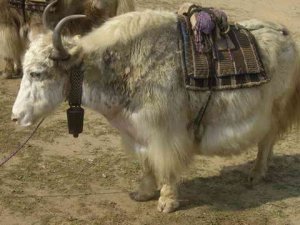 e one old fashioned pot bellied stove in the middle of the dining room, but that’s about it. The higher we go, the colder we get, and therefore the more down, fleece and Gortex one must cover the body in. My fingers freeze and it’s hard to type on the laptop. I stay wrapped all night in sweaters, wool gloves, and my long brown cashmere airplane blanket cum scarf. It’s just too cold to change out of your daily attire. And somehow, when there is a shower, you have to gather up the courage to get in it. Jim tells me this is probably the last of the hot water showers, here in Pangboche, where we spend two nights in a small lodge owned by the daughter of the highly respected lama here. It certainly can boast of the last of the Western style toilets on the route toward base camp.
e one old fashioned pot bellied stove in the middle of the dining room, but that’s about it. The higher we go, the colder we get, and therefore the more down, fleece and Gortex one must cover the body in. My fingers freeze and it’s hard to type on the laptop. I stay wrapped all night in sweaters, wool gloves, and my long brown cashmere airplane blanket cum scarf. It’s just too cold to change out of your daily attire. And somehow, when there is a shower, you have to gather up the courage to get in it. Jim tells me this is probably the last of the hot water showers, here in Pangboche, where we spend two nights in a small lodge owned by the daughter of the highly respected lama here. It certainly can boast of the last of the Western style toilets on the route toward base camp.
The road (path) from Namche Bazaar to Pangboche is probably the most difficult of this foot safari. It’s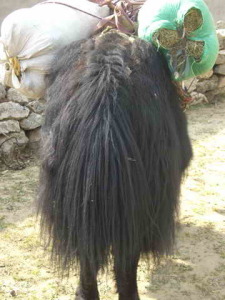 the principle highway for gear and supplies going to and from the Base Camp of Mt. Everest. The dust stirred up by people, yaks, naks (female yaks), an occasional horse and the cross-bred zoe turns the trekker into a nose blowing, sneezing, throat clearing, coughing idiot. When the wind whips up in the afternoon, it’s like living in a whirlwind. You constantly have to move to the side for yaks and porters carrying amazing loads that range from stacks of lumber, to huge jugs of kerosene or water, to garbage being brought down from Base Camp.
the principle highway for gear and supplies going to and from the Base Camp of Mt. Everest. The dust stirred up by people, yaks, naks (female yaks), an occasional horse and the cross-bred zoe turns the trekker into a nose blowing, sneezing, throat clearing, coughing idiot. When the wind whips up in the afternoon, it’s like living in a whirlwind. You constantly have to move to the side for yaks and porters carrying amazing loads that range from stacks of lumber, to huge jugs of kerosene or water, to garbage being brought down from Base Camp.
Anyone who has booked a climb this year has already settled in base camp. It takes about two months of preparation and conditioning in the actual base camp level of altitude. One of the most discomforting aspects to me is that everyone is responsible for his own human waste removal. This is why visitors to camp are not very welcomed because they add to that burden. Nothing can be left on the mountain or in the base camp. Human waste is collected and brought back down the mountain by Sherpas to be buried in deep holes in a dry lake bed. All other garbage must be transported to Namche Bazaar where it’s separated into burnables and non-burnables. Oxygen bottles, batteries, non recycle cooking gas canisters must be taken back home or sent back to the country of origin. Most oxygen bottles come from Russia where they are tested, refilled, recertified and sent back for another use for a total of three times per bott le.
le.
Our daily trekking log leaving Namche started out pleasantly as the sun rose. For two hours we followed a rather flat trail with only a few ups and downs around the sides of forever mountains. Around the first curve was the spectacular view of Mt. Everest and all its partner mountains, so tall that it’s hard to imagine anyone could deign to tackle the conditions and the hours to get up there. All the mountains Ama Da Blam (Grandmother’s Jewel Purse), Lhostse, Nuptse (in front of Everest), Cantega , Tawache have been summited. Some are actually harder than Everest, but Everest is the highest and therefore it’s the one men and some women feel they need to own in their souls. You really can never own Mt. Everest. You can only spend ten or fifteen minutes – photo minutes – at the top, and never feel comfortable wrapped in face masks, oxygen tubes, dark glasses, frozen beards, every kind of warmth protector and boots thicker than a triple decker sandwich. I look up at this nemesis of so many climbers and wonder if God created these peaks to show humans that nature is much more formidable than they are. The greatest climbers and the Sherpas attempt these challenges to learn more about their own spirits and endurance abilities, not because they want to be focus of a documentary, or write a book, or to make money in some commercial way. It’s one way to learn what you are made of, if anything at all.
A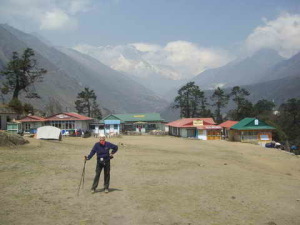 fter two hours on the trail – I was cheerful thinking I can do this, I’m acclimitized – we began a difficult hour downward trek to a raging river, full of milky green water splashing over enormous white and gray boulders. We crossed a bridge and began a trek back up hill, stopping briefly for a cup of hot lemon juice and a Snickers at the bottom. I was feeling good and was amazed at my strength at this point. I had energy to burn and didn’t want to sit and rest too long, trying to make decent time. I had been warned this was the most difficult and longest day of my excursion (We left at 8 a.m. and arrived about 3:45 p.m.). Then began the uphill push. Nima Tashe, a fine Sherpa who had been on successful expeditions with Jim in 2002 and 2007, but is more famous for the 50th anniversary summit with the sons of Edmund Hillary and Tenzing Norgay, joined us on this difficult ascent to his home town. He told us to take the old trail which meant less traffic, less dust, less sun, and a bit longer. It was excruciating for my soul and my lower back. So many times I wanted to burst into tears but then I knew I had to do it since it was a long ways back and this was what I was here for. So I pushed on, huffing and puffing as we ascended 1300 feet higher than Namche.
fter two hours on the trail – I was cheerful thinking I can do this, I’m acclimitized – we began a difficult hour downward trek to a raging river, full of milky green water splashing over enormous white and gray boulders. We crossed a bridge and began a trek back up hill, stopping briefly for a cup of hot lemon juice and a Snickers at the bottom. I was feeling good and was amazed at my strength at this point. I had energy to burn and didn’t want to sit and rest too long, trying to make decent time. I had been warned this was the most difficult and longest day of my excursion (We left at 8 a.m. and arrived about 3:45 p.m.). Then began the uphill push. Nima Tashe, a fine Sherpa who had been on successful expeditions with Jim in 2002 and 2007, but is more famous for the 50th anniversary summit with the sons of Edmund Hillary and Tenzing Norgay, joined us on this difficult ascent to his home town. He told us to take the old trail which meant less traffic, less dust, less sun, and a bit longer. It was excruciating for my soul and my lower back. So many times I wanted to burst into tears but then I knew I had to do it since it was a long ways back and this was what I was here for. So I pushed on, huffing and puffing as we ascended 1300 feet higher than Namche.
Finally after a tedious hour we reached Tengboche, site of the major administrative monastery in the Khumbu. As we passed through the elaborate gate, and took photos in front of the lions at the entrance, great swirls of dust surrounded us and sneezing began. All I could see w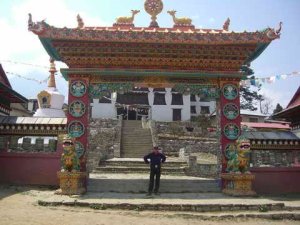 as a tea house with the large words Bakery written on the front. We headed there and were rewarded with a piece of lemon meringue pie that was absolutely delicious. We collected some croissants (these things are not found anywhere in the Khumbu) for the next breakfast, and finally headed out a bit more rested to reach Pangboche, our destination for the night. This part of the trek included a long down hill, once again to the river where a Buddhist nunnery resides, a wobbly bridge crossing, and then a straight up hill climb that seemed like it would never end. Nima and our regular Sherpa Suka were right at my elbows to lift me up when a step was too high for my sagging muscles or my vertigo kicked in because it was straight down thousands of feet on one side of the trail. It was embarrassing to have to be helped up, but it was comforting at the same time. These people really care about your safety. About 3:30 we passed through the gate of Pangboche, a charming village, home of the oldest monastery in the Khumbu, laid out on tiers of lan
as a tea house with the large words Bakery written on the front. We headed there and were rewarded with a piece of lemon meringue pie that was absolutely delicious. We collected some croissants (these things are not found anywhere in the Khumbu) for the next breakfast, and finally headed out a bit more rested to reach Pangboche, our destination for the night. This part of the trek included a long down hill, once again to the river where a Buddhist nunnery resides, a wobbly bridge crossing, and then a straight up hill climb that seemed like it would never end. Nima and our regular Sherpa Suka were right at my elbows to lift me up when a step was too high for my sagging muscles or my vertigo kicked in because it was straight down thousands of feet on one side of the trail. It was embarrassing to have to be helped up, but it was comforting at the same time. These people really care about your safety. About 3:30 we passed through the gate of Pangboche, a charming village, home of the oldest monastery in the Khumbu, laid out on tiers of lan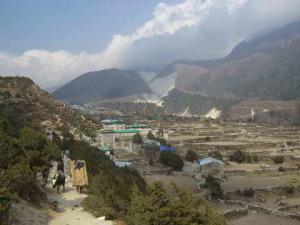 d where potatoes are the main product. On all sides are the most majestic mountains and the tallest mountains in the world. All are snow covered. All change their faces as the sun moves across. Pangboche itself is as 13,000 feet, high as the Grand Teton in Wyoming.
d where potatoes are the main product. On all sides are the most majestic mountains and the tallest mountains in the world. All are snow covered. All change their faces as the sun moves across. Pangboche itself is as 13,000 feet, high as the Grand Teton in Wyoming.
In my usual exhaustion from over-exertion, I began to freeze in the evening breeze, and wrapped up in two thick blankets, a wool hat, gloves, and a hot water bottle – until it was time to crawl up a creepy ladder to the dining room where the pot stove was burning and the room was filled with loud Russian trekkers. All four of us were tired, Karen and I kept laying down on the benches, unable to keep our heads up, a sign, I guess of a good days haul. I got numerous hugs because I had made it on the hardest trekking day.
 e one old fashioned pot bellied stove in the middle of the dining room, but that’s about it. The higher we go, the colder we get, and therefore the more down, fleece and Gortex one must cover the body in. My fingers freeze and it’s hard to type on the laptop. I stay wrapped all night in sweaters, wool gloves, and my long brown cashmere airplane blanket cum scarf. It’s just too cold to change out of your daily attire. And somehow, when there is a shower, you have to gather up the courage to get in it. Jim tells me this is probably the last of the hot water showers, here in Pangboche, where we spend two nights in a small lodge owned by the daughter of the highly respected lama here. It certainly can boast of the last of the Western style toilets on the route toward base camp.
e one old fashioned pot bellied stove in the middle of the dining room, but that’s about it. The higher we go, the colder we get, and therefore the more down, fleece and Gortex one must cover the body in. My fingers freeze and it’s hard to type on the laptop. I stay wrapped all night in sweaters, wool gloves, and my long brown cashmere airplane blanket cum scarf. It’s just too cold to change out of your daily attire. And somehow, when there is a shower, you have to gather up the courage to get in it. Jim tells me this is probably the last of the hot water showers, here in Pangboche, where we spend two nights in a small lodge owned by the daughter of the highly respected lama here. It certainly can boast of the last of the Western style toilets on the route toward base camp.The road (path) from Namche Bazaar to Pangboche is probably the most difficult of this foot safari. It’s
 the principle highway for gear and supplies going to and from the Base Camp of Mt. Everest. The dust stirred up by people, yaks, naks (female yaks), an occasional horse and the cross-bred zoe turns the trekker into a nose blowing, sneezing, throat clearing, coughing idiot. When the wind whips up in the afternoon, it’s like living in a whirlwind. You constantly have to move to the side for yaks and porters carrying amazing loads that range from stacks of lumber, to huge jugs of kerosene or water, to garbage being brought down from Base Camp.
the principle highway for gear and supplies going to and from the Base Camp of Mt. Everest. The dust stirred up by people, yaks, naks (female yaks), an occasional horse and the cross-bred zoe turns the trekker into a nose blowing, sneezing, throat clearing, coughing idiot. When the wind whips up in the afternoon, it’s like living in a whirlwind. You constantly have to move to the side for yaks and porters carrying amazing loads that range from stacks of lumber, to huge jugs of kerosene or water, to garbage being brought down from Base Camp.Anyone who has booked a climb this year has already settled in base camp. It takes about two months of preparation and conditioning in the actual base camp level of altitude. One of the most discomforting aspects to me is that everyone is responsible for his own human waste removal. This is why visitors to camp are not very welcomed because they add to that burden. Nothing can be left on the mountain or in the base camp. Human waste is collected and brought back down the mountain by Sherpas to be buried in deep holes in a dry lake bed. All other garbage must be transported to Namche Bazaar where it’s separated into burnables and non-burnables. Oxygen bottles, batteries, non recycle cooking gas canisters must be taken back home or sent back to the country of origin. Most oxygen bottles come from Russia where they are tested, refilled, recertified and sent back for another use for a total of three times per bott
 le.
le.Our daily trekking log leaving Namche started out pleasantly as the sun rose. For two hours we followed a rather flat trail with only a few ups and downs around the sides of forever mountains. Around the first curve was the spectacular view of Mt. Everest and all its partner mountains, so tall that it’s hard to imagine anyone could deign to tackle the conditions and the hours to get up there. All the mountains Ama Da Blam (Grandmother’s Jewel Purse), Lhostse, Nuptse (in front of Everest), Cantega , Tawache have been summited. Some are actually harder than Everest, but Everest is the highest and therefore it’s the one men and some women feel they need to own in their souls. You really can never own Mt. Everest. You can only spend ten or fifteen minutes – photo minutes – at the top, and never feel comfortable wrapped in face masks, oxygen tubes, dark glasses, frozen beards, every kind of warmth protector and boots thicker than a triple decker sandwich. I look up at this nemesis of so many climbers and wonder if God created these peaks to show humans that nature is much more formidable than they are. The greatest climbers and the Sherpas attempt these challenges to learn more about their own spirits and endurance abilities, not because they want to be focus of a documentary, or write a book, or to make money in some commercial way. It’s one way to learn what you are made of, if anything at all.
A
 fter two hours on the trail – I was cheerful thinking I can do this, I’m acclimitized – we began a difficult hour downward trek to a raging river, full of milky green water splashing over enormous white and gray boulders. We crossed a bridge and began a trek back up hill, stopping briefly for a cup of hot lemon juice and a Snickers at the bottom. I was feeling good and was amazed at my strength at this point. I had energy to burn and didn’t want to sit and rest too long, trying to make decent time. I had been warned this was the most difficult and longest day of my excursion (We left at 8 a.m. and arrived about 3:45 p.m.). Then began the uphill push. Nima Tashe, a fine Sherpa who had been on successful expeditions with Jim in 2002 and 2007, but is more famous for the 50th anniversary summit with the sons of Edmund Hillary and Tenzing Norgay, joined us on this difficult ascent to his home town. He told us to take the old trail which meant less traffic, less dust, less sun, and a bit longer. It was excruciating for my soul and my lower back. So many times I wanted to burst into tears but then I knew I had to do it since it was a long ways back and this was what I was here for. So I pushed on, huffing and puffing as we ascended 1300 feet higher than Namche.
fter two hours on the trail – I was cheerful thinking I can do this, I’m acclimitized – we began a difficult hour downward trek to a raging river, full of milky green water splashing over enormous white and gray boulders. We crossed a bridge and began a trek back up hill, stopping briefly for a cup of hot lemon juice and a Snickers at the bottom. I was feeling good and was amazed at my strength at this point. I had energy to burn and didn’t want to sit and rest too long, trying to make decent time. I had been warned this was the most difficult and longest day of my excursion (We left at 8 a.m. and arrived about 3:45 p.m.). Then began the uphill push. Nima Tashe, a fine Sherpa who had been on successful expeditions with Jim in 2002 and 2007, but is more famous for the 50th anniversary summit with the sons of Edmund Hillary and Tenzing Norgay, joined us on this difficult ascent to his home town. He told us to take the old trail which meant less traffic, less dust, less sun, and a bit longer. It was excruciating for my soul and my lower back. So many times I wanted to burst into tears but then I knew I had to do it since it was a long ways back and this was what I was here for. So I pushed on, huffing and puffing as we ascended 1300 feet higher than Namche.Finally after a tedious hour we reached Tengboche, site of the major administrative monastery in the Khumbu. As we passed through the elaborate gate, and took photos in front of the lions at the entrance, great swirls of dust surrounded us and sneezing began. All I could see w
 as a tea house with the large words Bakery written on the front. We headed there and were rewarded with a piece of lemon meringue pie that was absolutely delicious. We collected some croissants (these things are not found anywhere in the Khumbu) for the next breakfast, and finally headed out a bit more rested to reach Pangboche, our destination for the night. This part of the trek included a long down hill, once again to the river where a Buddhist nunnery resides, a wobbly bridge crossing, and then a straight up hill climb that seemed like it would never end. Nima and our regular Sherpa Suka were right at my elbows to lift me up when a step was too high for my sagging muscles or my vertigo kicked in because it was straight down thousands of feet on one side of the trail. It was embarrassing to have to be helped up, but it was comforting at the same time. These people really care about your safety. About 3:30 we passed through the gate of Pangboche, a charming village, home of the oldest monastery in the Khumbu, laid out on tiers of lan
as a tea house with the large words Bakery written on the front. We headed there and were rewarded with a piece of lemon meringue pie that was absolutely delicious. We collected some croissants (these things are not found anywhere in the Khumbu) for the next breakfast, and finally headed out a bit more rested to reach Pangboche, our destination for the night. This part of the trek included a long down hill, once again to the river where a Buddhist nunnery resides, a wobbly bridge crossing, and then a straight up hill climb that seemed like it would never end. Nima and our regular Sherpa Suka were right at my elbows to lift me up when a step was too high for my sagging muscles or my vertigo kicked in because it was straight down thousands of feet on one side of the trail. It was embarrassing to have to be helped up, but it was comforting at the same time. These people really care about your safety. About 3:30 we passed through the gate of Pangboche, a charming village, home of the oldest monastery in the Khumbu, laid out on tiers of lan d where potatoes are the main product. On all sides are the most majestic mountains and the tallest mountains in the world. All are snow covered. All change their faces as the sun moves across. Pangboche itself is as 13,000 feet, high as the Grand Teton in Wyoming.
d where potatoes are the main product. On all sides are the most majestic mountains and the tallest mountains in the world. All are snow covered. All change their faces as the sun moves across. Pangboche itself is as 13,000 feet, high as the Grand Teton in Wyoming.In my usual exhaustion from over-exertion, I began to freeze in the evening breeze, and wrapped up in two thick blankets, a wool hat, gloves, and a hot water bottle – until it was time to crawl up a creepy ladder to the dining room where the pot stove was burning and the room was filled with loud Russian trekkers. All four of us were tired, Karen and I kept laying down on the benches, unable to keep our heads up, a sign, I guess of a good days haul. I got numerous hugs because I had made it on the hardest trekking day.
Photos: A white yak; the back end of a yak; Mt. Everest on the trail; the bakery at Tengboche; Tengboche monastery entrance; Arriving at Pangboche.
See map.

I could empathize with you every step of the way. I’ve done that trail many times and it’s hard. I used to lead treks to the Everest Base Camp and worked with a group of Sherpas to create the first hut system in Nepal in 1990–the Sherpa Guide Lodges. I’ve been so appalled at the lack of credit Sherpas receive for their efforts, especially on Everest, that I’ve written a novel about them. I chose fiction because if afforded a more intimate portrait. Every bit if information in there is accurate and well researched.
In Beyond the Summit by Linda LeBlanc, details of Sherpa culture and religion are interwoven in a tale of romance and high adventure. The story has something for everyone: a love affair between an American journalist and Sherpa guide, conflict between generations as the modern world challenges centuries of tradition, an expedition from the porter’s point of view.
Below are selections from reviews. To read the complete ones and excerpts go to http://www.beyondthesummit-novel.com
Beyond the Summit, is the rare gem that shows us the triumphs and challenges of a major climb from the porter’s point of view. The love of two people from diverse cultures is the fiery centerpiece of a novel that leads its readers through harshly beautiful and highly dangerous territory to the roof of the world. Malcolm Campbell, book reviewer
Conflict and dialog keep this gripping story of destiny, romance and adventure moving from the first page to the last paragraph. LeBlanc has a genius for bonding her readers and her characters. I found I was empathizing in turn with each character as they faced their own personal crisis or trauma.
Richard Blake for Readers Views.
A gripping, gut-twisting expedition through the eyes of a porter reveals the heart and soul of Sherpas living in the shadows of Everest. EverestNews.com
A hard-hitting blend of adventure and romance which deserves a spot in any serious fiction collection. Midwest Book Review
LeBlanc is equally adept at describing complex, elusive emotions and the beautiful, terrifying aspect of the Himalayan Mountains. Boulder Daily Camera
LeBlanc’s vivid description of the Himalayas and the climbing culture makes this a powerful read. Rocky Mt News Pick of the Week
A rich adventure into the heart of the Himalayan Kingdom. Fantastic story-telling from one who has been there. USABookNews.com
This is the book to read before you embark on your pilgrimage to Nepal. The author knows and loves the people and the country, and makes you feel the cold thin air, the hard rocks of the mountains, the tough life of the Sherpa guides, and you learn to love them too. This is a higly literate, but also very readable book. Highly recommended.”
– John (college professor)
Memorable characters and harrowing encounters with the mountains keep the action moving with a vibrant balance of vivid description and dialog. Literary Cafe Host, Healdsburg, CA
This superbly-crafted novel will land you in a world of unimaginable beauty, adventure, and romance. The love story will keep you awake at night with its vibrant tension and deep rich longing. Wick Downing, author of nine novels
Such vividly depicted images of the Everest region and the Sherpa people are the perfect scenario for the romance and adventure feats narrated. It’s a page-turner, so engrossing you end up wanting to visit Nepal! Not just novel, but perfect for those seeking to get acquainted with the culture of this country.
By Claudia Fournier (América, Bs. As., Argentina)
Available through Barnes and Noble, Borders, amazon.com, Chesslerbooks.com, and the web site